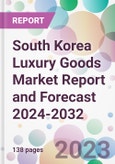Luxury goods, encompassing high-end apparel, accessories, cosmetics, timepieces, jewellery, and more, have always had a significant appeal in South Korea. The country, with its strong economic landscape, boasts a consumer market with an evolved sartorial and luxury taste, underlined by a culture that values aesthetics, craftsmanship, and brand prestige.
A major factor driving South Korea luxury goods market growth is the rapid urbanisation and the emergence of a burgeoning middle class in the country. With increased disposable incomes, the South Korean consumer now possesses the means to indulge in luxury items, viewing them not merely as purchases but as investments and symbols of elevated social status.
Moreover, South Korea's cultural landscape, particularly the global influence of its entertainment industry known as the Hallyu wave has been instrumental in steering luxury consumption. As per the South Korea luxury goods market analysis, K-pop idols, film stars, and influential personalities, donning luxury brands, serve as trendsetters, setting aspirational benchmarks for their vast fan base, both domestically and internationally. The conspicuous display of luxury products in popular K-dramas further propels the desirability quotient of these high-end goods.
The technological advancements in the retail sector, especially the advent of e-commerce platforms, have also played a pivotal role in widening the luxury market's scope and propelling the South Korea luxury goods market demand. Virtual showrooms augmented reality-driven trials, and highly personalised shopping experiences online have made luxury shopping more accessible, interactive, and convenient, propelling online sales.
Additionally, the luxury districts of Gangnam, Cheongdam-dong, and Apgujeong in Seoul are not only shopping destinations but also places of leisure, entertainment, and socialisation. These areas, lined with flagship stores of global luxury giants, offer immersive brand experiences, events, and personalised services that resonate with the Korean consumer's preference for exclusivity, contributing value to the South Korea luxury goods market size.
Market Segmentation
The market can be divided based on product, end use, and distribution channel.
Market Breakup by Product
- Watches and Jewellery
- Leather Goods
- Perfumes and Cosmetics
- Clothing
- Eyewear
- Others
Market Breakup by End Use
- Women
- Men
Market Breakup by Distribution Channel
- Offline
- Online
Competitive Landscape
The report looks into the market shares, plant turnarounds, capacities, investments, and mergers and acquisitions, among other major developments, of the leading companies operating in the South Korea luxury goods market. Some of the major players explored in the report are as follows:- LVMH Moët Hennessy
- Compagnie Financière Richemont SA
- Kering Group
- The Swatch Group Ltd
- Chanel
- ROLEX SA
- Minjukim
- Guccio Gucci S.p.A.
- Chanel
- Prada S.p.A
- Others
Table of Contents
Companies Mentioned
- LVMH Moët Hennessy
- Compagnie Financière Richemont SA
- Kering Group
- The Swatch Group Ltd
- Chanel
- ROLEX SA
- Minjukim
- Guccio Gucci S.p.A.
- Prada S.p.A
Methodology

LOADING...








